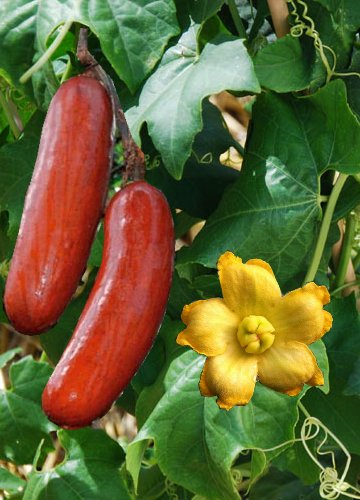
|
|
Cassabanana (Sicana odorifera).
Leaves, flower and fruit.
|
Cassabanana - Sicana odorifera
Sicana odorifera (Cassabanana), the only species of the genus Sicana, is a large, herbaceous perennial vine of the gourd family (Cucurbitaceae), native to tropical South America, grown as an ornamental plant and for its sweet edible fruit. English names include cassabanana or casbanan, sikana, and musk cucumber.
The vine is perennial, herbaceous, fast-growing, heavy, requiring a strong trellis; climbing trees to 50 ft (15 m) or more by means of 4-parted tendrils equipped with adhesive discs that can adhere tightly to the smoothest surface. Young stems are hairy. The leaves are gray-hairy, rounded-cordate or rounded kidney-shaped, to 1 ft (30 cm) wide, deeply indented at the base, 3-lobed, with wavy or toothed margins, on petioles 1 1/2 to 4 3/4 in (4-12 cm) long.
Both male and female borne on the same plant. Flowers are white or yellow, urn-shaped, 5-lobed, solitary, the male 3/4 in (2 cm) long, the female about 2 in (5 cm) long.
Renowned for its strong, sweet, agreeable, melon-like odor, the striking fruit is ellipsoid or nearly cylindrical, sometimes slightly curved; 12 to 24 in (30-60 cm) in length, 2 3/4 to 4 1/2 in (7-11.25 cm) thick, hard-shelled, orange-red, maroon, dark-purple with tinges of violet, or entirely jet-black; smooth and glossy when ripe, with firm, orange-yellow or yellow, cantaloupe-like, tough, juicy flesh, 3/4 in (2 cm) thick. In the central cavity, there is softer pulp, a soft, fleshy core, and numerous flat, oval seeds, 5/8 in (16 mm) long and 1/4 in (6 mm) wide, light-brown bordered with a dark-brown stripe, in tightly-packed rows extending the entire length of the fruit.
The fruit has a delicious, melon-like taste when it is ripe, which needs high temperatures to ripen. The
sweet, aromatic, yellow-to-orange flesh of the mature fruit is eaten raw or made into preserves.
The ripe flesh, sliced thin, is eaten raw, especially in the summer when it is appreciated as cooling and refreshing. However, it is mainly used in the kitchen for making jam or other preserves. The immature fruit is cooked as a vegetable or in soup and stews.
The cassabanana is believed native to Brazil but it has been spread throughout tropical America. Historians have evidence that it was cultivated in Ecuador in pre-Hispanic times. It was first mentioned by European writers in 1658 as cultivated and popular in Peru. It is grown near sea-level in Central America but the fruit is carried to markets even up in the highlands. Venezuelans and Brazilians are partial to the vine as an ornamental, but in Cuba, Puerto Rico and Mexico it is grown for the usefulness of the fruit.
People like to keep the fruit around the house, and especially in linen- and clothes-closets, because of its long-lasting fragrance, and they believe that it repels moths. It is also placed on church altars during Holy Week.
In Puerto Rico, the flesh is cut up and steeped in water, with added sugar, overnight at room temperature so that it will ferment slightly. The resultant liquor is sipped frequently and strips of the flesh are eaten, too, to relieve sore throat. It is believed beneficial also to, at the same time, wear a necklace of the seeds around the neck.
The seed infusion is taken in Brazil as a febrifuge, vermifuge, purgative and emmenagogue. The leaves are employed in treating uterine hemorrhages and venereal diseases. In Yucatan, a decoction of leaves and flowers (2 g in 180cc water) is prescribed as a laxative, emmenagogue and vermifuge, with a warning not to make a stronger preparation inasmuch as the seeds and flowers yield a certain amount of hydrocyanic acid.
Cassabanana is grown from seeds or cuttings. A high temperature during the fruiting season is needed to assure perfect ripening. Brazilians train the vine to grow over arbors or they may plant it close to a tree. However, if it is allowed to climb too high up the tree there is the risk that it may smother and kill it.
In temperate areas the cassabanana
can be cultivated as an annual plant but may not bear flowers or fruit.
It needs good drainage to grow well, and does well on an acidic mix of sand (or perlite) and rich compost.
Source:
http://en.wikipedia.org/wiki/Sicana_odorifera
https://www.hort.purdue.edu/newcrop/morton/cassabanana.html
